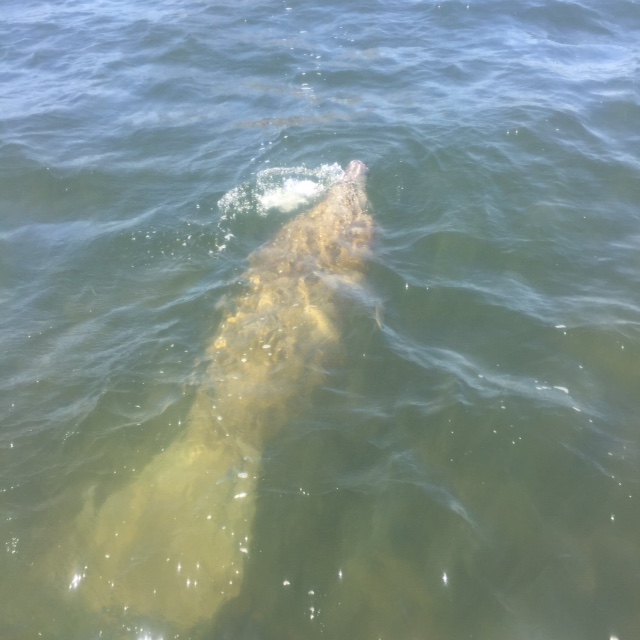
by Rick O'Connor | Jun 7, 2019
This is becoming an annual summer encounter – manatees in (near) the Intracoastal Waterway of Pensacola Bay area. They have been before, it is not uncommon for them to be seen at Palafox Pier Marina, but in the last few years groups of five to nine manatees have been spotted drifting along the shorelines and hanging around docks in Gulf Breeze and the Perdido Key area.
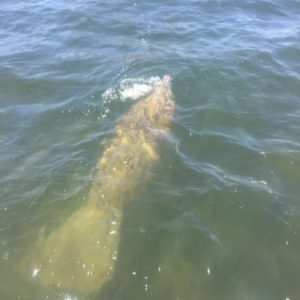
Manatee swimming in Big Lagoon near Pensacola.
Photo: Marsha Stanton
I cannot say what this means but we are not alone with these new visitors along the Gulf coast. There are enough manatee sightings in the lower portions of Mobile Bay that manatee signs have been placed along Magnolia River and a manatee watch hotline has been set up at Dauphin Island Sea Lab. There are at least 40 resident manatees in the Wakulla River. And now, at least in the last two years, small groups have been seen in our area. Concerned whether these manatees were returning to southwest Florida for the winter during the red tide, there were plans to tag some of them – I am not sure if that was done or not.
So, what does this mean for us?
Well, your first thought is the concern over boat strikes. The manatee has actually been protected by Florida law since 1893. Their numbers have increased to 6600 animals and so their status has been changed from endangered to threatened. That said, they are still protected by both the Endangered Species Act and the Marine Mammal Protection Act.
According to an FWC report, in 2018, 824 manatees died in Florida. The top five causes were (1) Natural causes – 27%, (2) Undetermined – 20%, (3) Watercraft – 15%, (4) Perinatal death – 14%, and (5) Unrecovered – 13%.
There were 17 deaths reported from the Florida panhandle. Wakulla (7), Franklin and Escambia (3), Bay, Gulf, Okaloosa, and Walton (1).
Cold stress was the #1 cause of death (7) – Bay, Escambia, Franklin, Okaloosa, and Walton
Followed by boat strikes (4) – Wakulla (2), Escambia (2)
Unrecovered (3) – Franklin, Gulf, and Wakulla
Undetermined (2) – Wakulla
Perinatal (1) – Wakulla
Natural (1) – Wakulla
So far, in 2019 there have been 259 manatee fatalities. The top five causes were (1) Watercraft – 25%, (2) Undetermined – 24%, (3) Cold stress – 15%, (4) Unrecovered – 13%, and (5) Natural – 13%
In the Florida panhandle there have been four deaths so far. Bay County has had two due to cold stress and Wakulla has had two – one was unrecovered and the other was “other” but human related.
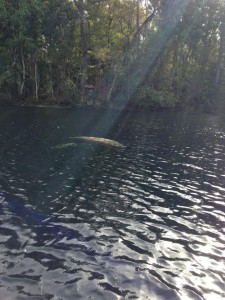
Manatees hanging out in Wakulla Springs.
Photo provided by Scott Jackson
So, statewide watercraft are still a big concern. Two of the three deaths in Escambia were boat related. The manatees tend to stay out of the boat channels, so it is recommend boaters remain in the navigable channels while heading to a destination and, when leaving the channel to reach that destination, go idle speed and have a lookout.
Manatees have actually benefitted the management of invasive hydrilla in the Wakulla River. FWC no longer has to treat it – the manatees are eating it all. Pensacola Bay is currently experiencing a bloom of epiphytic (attached) drift algae on the seagrass beds. Maybe, just maybe, the few manatees we see will consume as much algae they can.
I can understand the concern some boaters may have with manatees in the area. However, they do provide some benefits and are the highlight of the day for any local or visitor who may see them. We should welcome them and do what we can, within the law, to keep them safe. If you spot a manatee, please report it to the Dauphin Island Sea Lab hotline: 1-866-493-5803. Or email manatee@disl.org.

by Rick O'Connor | May 17, 2019
I am writing about this animal because, though it is rare to see them, our terrapin volunteers saw two this past week; and maybe you will too.
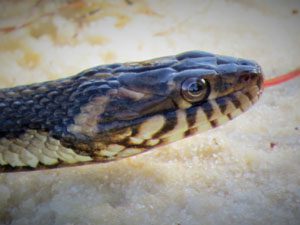
The round pupil and vertical jaw stripes indicate this is the nonvenomous Nerodia. Photo: Carole Tebay
The Gulf salt marsh snake is one of those, like the eastern coral snake, that is actually common – just rare to see. It is rare to see because (a) it lives in muddy salt marshes, where we rarely venture, and (b) it is mostly nocturnal – and even fewer of us venture into muddy salt marshes at night.
It is in the genus Nerodia, which includes the common water snakes like the banded water snake (Nerodia fasicata). It is a harmless nonvenomous snake. However, because of where it lives, it is often confused with a cottonmouth and is killed. A common name for this snake in Alabama is “bay moccasin”.
Their name is Nerodia clarkii, but it is a subspecies of this group – so the actual name is Nerodia clarkii clarkii. The other two subspecies are found in Florida. The Mangrove salt marsh snake (Nerodia clarkii compressicauda) is found from central Gulf coast of Florida, around the Keys to Indian River County on the Atlantic coast. The Atlantic salt marsh snake (Nerodia clarkii taeniata) has a very small range. Originally reported in Volusia, Brevard, and Indian River counties – due to the northern expansion of mangroves, it is believed to only be in Volusia County now. It is listed as THREATENED both federally and with the state. Our Gulf salt marsh snake is found from central Florida to Texas.
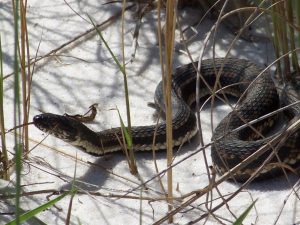
The nonvenomous Gulf Salt marsh Snake.
Photo: Molly O’Connor
It is a relatively small snake, only reaching a length of around 15-20 inches, though some have been reported at 30 inches. They possess two long yellowish-tan stripes running laterally the length of its body, the only species of Nerodia to do so. Again, they move at night feeding on small crabs, shrimp, frogs, and small fish. During daylight hours they hide beneath the wrack or other vegetation avoiding herons, egrets, and larger blue crabs. Lacking the needed glands, they cannot desalinate seawater the way sea turtles and terrapins can. All of their freshwater comes from their food and from rainfall.
They breed in the spring, possibly why we are seeing them now, and give live birth to about 10 young in midsummer. They are of moderate conservation concern in Alabama due to the loss of salt marsh. The loss of salt marsh habitat and rise of sea level are their major concerns at this point.
I do need to warn you, though it is a small, nonvenomous snake, they will bite. If bitten, soap and water will do the job. For me, and others, it is actually exciting to see them because of their reclusive nature. If you see one while exploring our intracoastal waters, know that you are not in any danger but rather lucky to see this “mystery of the marsh”.
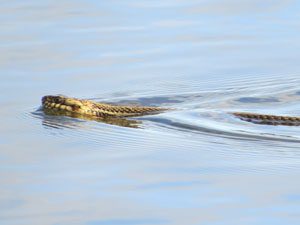
The Gulf Salt Marsh Snake swimming in a local marsh.
Photo: Carole Tebay
References
Gulf Salt Marsh Snake – Texas Parks and Recreation – https://tpwd.texas.gov/huntwild/wild/species/gulfsnake/.
iNaturalist – https://www.inaturalist.org/guide_taxa/776612.
Outdoor Alabama – Alabama Department of Conservation and Natural Resources – https://www.outdooralabama.com/non-venomous-snakes/gulf-saltmarsh-snake.
Atlantic Salt Marsh Snake – N.c.taeniata – U.S. Fish and Wildlife – https://www.fws.gov/northflorida/Species-Accounts/Atl-Salt-Marsh-Snake-2005.htm.

by Laura Tiu | May 3, 2019
There are five species of sea turtles that nest from May through August on Florida beaches, with hatching stretching out until October. The loggerhead, the green turtle, and the leatherback all nest regularly in the Panhandle, with the loggerhead being the most frequent visitor. Two other species, the hawksbill and Kemp’s Ridley nest infrequently. All five species are listed as either threatened or endangered under the Endangered Species Act. Due to their threatened and endangered status, the Fish and Wildlife Conservation Commission/Fish and Wildlife Research Institute monitors sea turtle nesting activity on an annual basis.
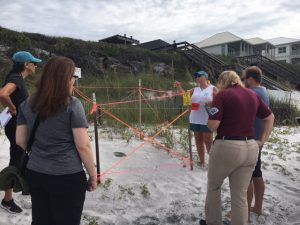
A group checks out a recently hatched sea turtle nest on the dunes in south Walton county in Florida.
Annual total nest counts for loggerhead sea turtles on Florida’s index beaches fluctuate widely and scientists do not yet understand fully what drives these changes. From 2011 to 2018, an average of 106,625 sea turtle nests (all species combined) were recorded annually on these monitored beaches. In 2018, there was a slight decrease in nests with only 96,945 nests recorded statewide. This is not a true reflection of all of the sea turtle nests each year in Florida, as it doesn’t cover every beach, but it gives a good indication of nesting trends and distribution of species.
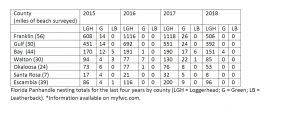
2015-2018 Florida Panhandle turtle nesting totals for all species.
If you want to see a sea turtle in the Florida Panhandle, please visit one of the state-permitted captive sea turtle facilities listed below, admission fees may be charged. Please call the number listed for more information.
- Gulf Specimen Marine Laboratory
222 Clark Dr
Panacea, FL 32346
850-984-5297
Admission Fee
- Gulf World Marine Park
15412 Front Beach Rd
Panama City, FL 32413
850-234-5271
Admission Fee
- Gulfarium Marine Adventure Park
1010 Miracle Strip Parkway SE
Fort Walton Beach, FL 32548
850-243-9046 or 800-247-8575
Admission Fee
- Navarre Beach Sea Turtle Center
8740 Gulf Blvd
Navarre, FL 32566
850-499-6774
The Foundation for The Gator Nation. An Equal Opportunity Institution
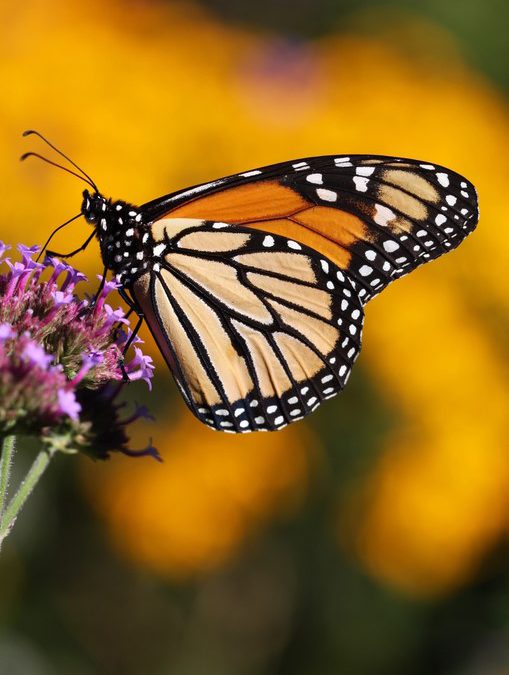
by Molly Jameson | Apr 18, 2019
With spring upon us, the mighty monarch butterflies have begun their long trek to the north from Mexico, looking to time their migration with growth of the milkweed plants in the southeastern United States. Mated monarch females lay hundreds of eggs along their journey, but only two percent of these eggs will survive to become mature caterpillars to carry on the next generation.

The monarch butterfly.
Photo: Steven Katovich USDA Forest Service
Monarch larvae rely exclusively on milkweed for nutrients, so it is of upmost importance that the plants are available to the offspring at the correct time. If the adult monarchs arrive too early, the milkweeds may not have had enough time to grow after late frosts. If they arrive too late, the milkweed vegetation may not support the nutrient needs of the caterpillars. In addition, the milkweeds contain a poisonous toxin, cardiac glycoside, that stays within the caterpillars’ bodies once consumed. This does not harm the larvae, but actually helps them, as it makes the young and adult butterflies taste terrible and makes them poisonous to potential predators.
For these reasons, it is important that we all do our part to support the growth of native milkweed species. Locally, the Monarch Milkweed Initiate at the St. Marks National Wildlife Refuge educates the public about milkweed and monarchs and grows and transplants native milkweed to support the monarchs on their migration.
When planting milkweed, be aware that there is a popular commercialized non-native tropical milkweed species that is not appropriate for the monarchs in our area. This species, Asclepias curassavica, can flower year-round, luring the monarchs to stay and breed in the winter when they should be on their way back to Mexico to escape freezing temperatures. Staying and breeding too long can make the monarchs susceptible to a protozoan parasite, Ophryocystis elektroscirrha (OE for short), that infects the caterpillars when feeding, reducing their lifespan, body mass, mating success rate, and ability to migrate.
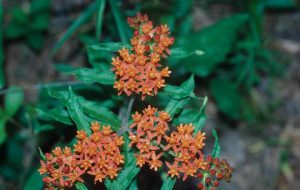
Butterfly milkweed (Asclepias tuberosa)
Photo: John Ruter, University of Georgia

Swamp milkweed (Asclepias incarnata).
Photo: David Cappaert
Luckily, there are about 21 native milkweed species in Florida. Many native milkweeds in the Florida Panhandle require specialized care when grown for transplanting, as different species have adapted to a range of habitats. The Asclepias tuberosa, commonly referred to as butterflyweed, is considered easiest to grow as they transplant well and thrive in full sun. Others, such as Asclepias perennis, or aquatic milkweed, and Asclepias incarnata, swamp milkweed, must be grown using trays without drain holes, as their “feet” must be kept wet. The Asclepias humistrata, or sandhill milkweed, requires a drier, heavier soil.
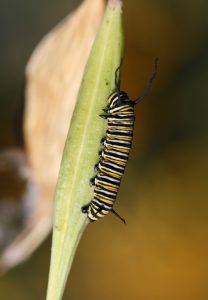
Monarch catepillar (Danaus plexippus).
Photo: Steven Katovich, USDA Forest Service
To support the monarchs and grow milkweed in your garden, come to the Leon County Extension Office at 615 Paul Russell Road on Saturday, May 11, from 9:00 a.m. to 1:00 p.m. for the Spring Open House and Plant Sale. Master Gardeners have been busy growing native milkweeds for this event and will be on hand selling the transplants. There will also be many other Florida Friendly and native plants available, along with guided garden tours, kids’ activities, the UF/IFAS Bookstore, a silent auction, live music by the Tallahassee Woodwind Quintet, refreshments, and Master Gardeners and Extension Agents on-hand to answer any of your gardening questions.
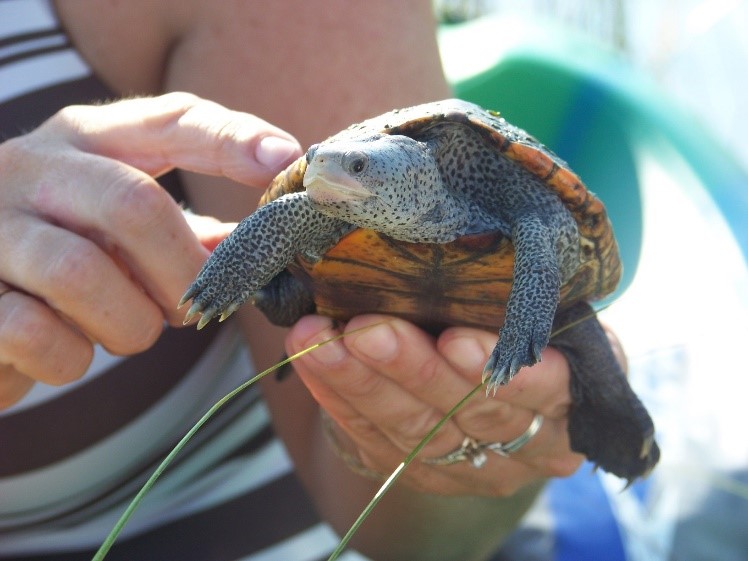
by Ray Bodrey | Apr 17, 2019
Soon, two important ecological surveys will begin in Gulf County, concerning both diamondback terrapins and mangroves.
Florida is home to five subspecies of diamondback terrapin, three of which occur exclusively in Florida. Diamondback terrapins live in coastal marshes, tidal creeks, mangroves, and other brackish or estuarine habitats. However, the diamondback terrapin is currently listed as a Species of Greatest Conservation Need (SGCN).
Diamondback terrapin populations, unfortunately, are nationally in decline. Human activities, such as pollution, land development and crabbing without by-catch reduction devices are often reasons for the decline, but decades ago they were almost hunted to extinction for their tasty meat. The recent decline has raised concern of not only federal agencies, but also organizations and community groups on the state and local levels. Diamondback Terrapin range is thought to have once been all of coastal Florida, including the Keys.
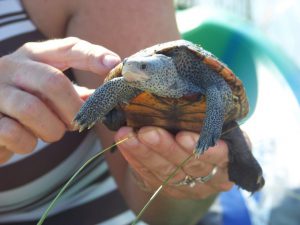
Figure 1: Diamondback Terrapin.
Credit: Rick O’Connor, UF/IFAS Extension & Florida Sea Grant, Escambia County.
Mangroves, a shoreline plant species of south Florida, are migrating north and are now being found in the Panhandle. Both red and black mangroves have been found in St. Joseph Bay. Mangroves establishment could be an important key to a healthy bay ecosystem, as a factor in shoreline restoration and critical aquatic life habitat.
Currently there is a significant data gap for both diamondback terrapin and mangrove populations. Therefore, there is a great need to conduct assessments to learn more about their geographic distribution.
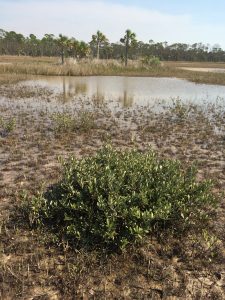
Figure 2. Black Mangrove in St. Joseph Bay.
Credit: Ray Bodrey, UF/IFAS Extension & Florida Sea Grant, Gulf County.
The Forgotten Coast Sea Turtle Center is partnering with UF/IFAS Extension & Florida Sea Grant to assist in surveying and monitoring diamondback terrapins and mangroves in St. Joseph Bay, and we need your help! UF/IFAS Extension & Florida Sea Grant Agent’s Rick O’Connor and Ray Bodrey are providing a training workshop for volunteers and coordinating surveys for St. Joseph Bay. Terrapin surveys require visiting an estuarine location where terrapin nesting sites and mangrove plants are highly probable. Volunteers will visit their assigned locations at least once a week during the months of May and June and complete data sheets for each trip. Each survey takes about two hours, and some locations may require a kayak to reach.
If you are interested in volunteering for these important projects, we will hold a training session on Monday, April 22nd at 1:00 p.m. ET at the Forgotten Coast Sea Turtle Center (located at 1001 10th Street, Port St. Joe).
For more information, please contact:
Ray Bodrey, UF/IFAS Extension Gulf County, Extension Director
rbodrey@ufl.edu
(850) 639-3200
UF/IFAS Extension is an Equal Opportunity Institution.
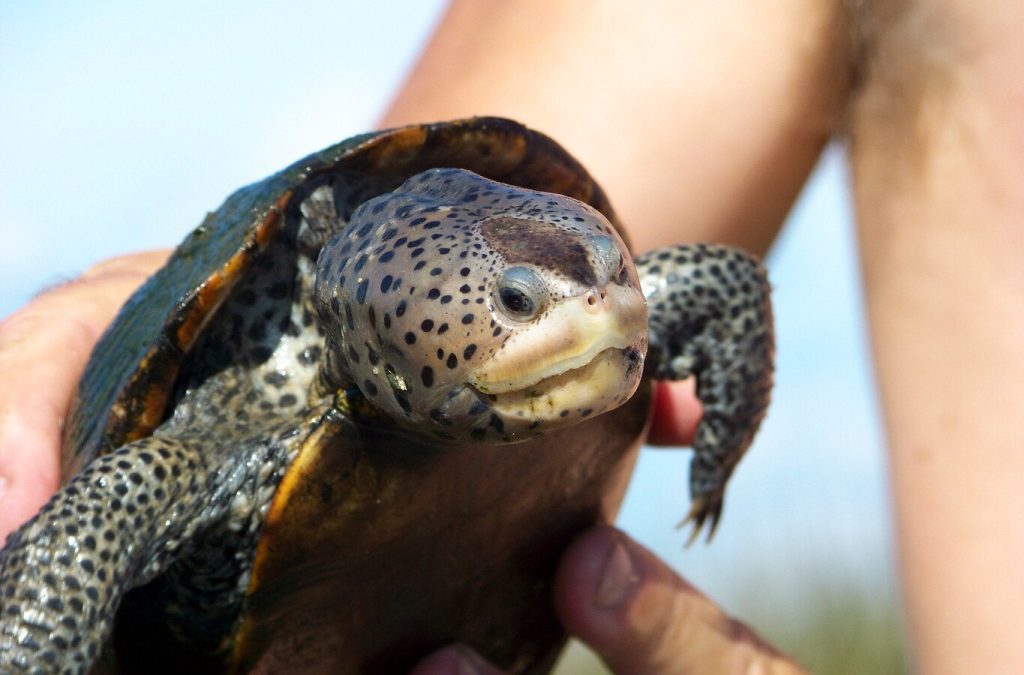
by Rick O'Connor | Mar 29, 2019
We have a lot of really cool and interesting creatures that live in our bay, but one many may not know about is a small turtle known as a diamondback terrapin. Terrapins are usually associated with the Chesapeake Bay area, but actually they are found along the entire eastern and Gulf coast of the United States. It is the only resident turtle of brackish-estuarine environments, and they are really cool looking.
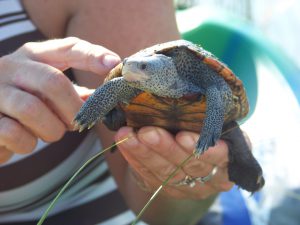
The diamond in the marsh. The diamondback terrapin.
Photo: Molly O’Connor
Terrapins are usually between five and 10 inches in length (this is the shell measurement) and have a grayish-white colored skin, as opposed to the dark green-black found on most small riverine turtles in Florida. The scutes (scales) of the shell are slightly raised and ridged to look like diamonds (hence their name). They are not migratory like sea turtles, but rather spend their entire lives in the marshes near where they were born. They meander around the shorelines and creeks of these habitats, sometimes venturing out into the seagrass beds, searching for shellfish – their favorite prey. Females do come up on beaches to lay their eggs but unlike sea turtles, they prefer to do this during daylight hours and usually close to high tide.
Most folks living here along the Gulf coast have not heard of this turtle, let alone seen one. They are very cryptic and difficult to find. Unlike sea turtles, we usually do not give them a second thought. However, they are one of the top predators in the marsh ecosystem and control plant grazing snails and small crabs. During the 19th century they were prized for their meat in the Chesapeake area. As commonly happens, we over harvested the animal and their numbers declined. As numbers declined the price went up and the popularity of the dish went down. There was an attempt to raise the turtles on farms here in the south for markets up north. One such farm was found at the lower end of Mobile Bay.
Early 20th century still found terrapin on some menus, but the popularity began to wane, and the farms slowly closed. Afterwards, the population terrapins began to rebound – that was until the development of the wire meshed crab trap. Developed for the commercial and recreational blue crab fishery, terrapins made a habitat of swimming into these traps, where they would drown. In the Chesapeake Bay area, the problem was so bad that excluder devices were developed and required on all crab traps. They are not required here in Florida, where the issue is not as bad, but we do have these excluders at the extension office if any crabber has been plagued with capturing terrapins. Studies conducted in New Jersey and Florida found these excluder devices were effective at keeping terrapins out of crab traps but did not affect the crab catch itself. Crabs can turn sideways and still enter the traps.
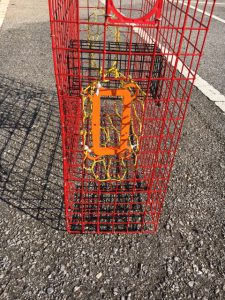
This orange plastic rectangle is a Bycatch Reduction Device (BRD) used to keep terrapins out of crab traps – but not crabs.
Photo: Rick O’Connor
Another 20th century issue has been nesting predation by raccoons. As we began to build roads and bridges to isolated marsh islands in our bays, we unknowingly provided a highway for these predators to reach the islands as well. On some islands, raccoons depredated 90% of the terrapin nests. Today, these turtles are protected in every state they inhabit except Florida. Though there is currently no protection for the terrapin itself in our state, they do fall under the general protection for all riverine turtles; you may only possess two at any time and may not possess their eggs.
Some scientists have discussed identifying terrapins as a sentinel species for the health of estuaries. Not having terrapin in the bay does not necessarily mean the bay is unhealthy, but the decline of this turtle (or the blue crab) could increase the population of smaller plant grazing invertebrates they eat throwing off the balance within the system.
Sea Grant trains local volunteers to survey for these creatures within our bay area. Trainings usually take place in April and surveys are conducted during May and June. This year we will be training volunteers in the Perdido area on April 10 at the Southwest Branch of the Pensacola Library on Gulf Beach Highway. That training will begin at 10:00 AM. For Pensacola Beach the training will be on April 15 at the Navarre Beach Sea Turtle Conservation Center on Navarre Beach. That training will begin at 9:00 AM. A third training will take place on April 22 at the Port St. Joe Sea Turtle Center in Port St. Joe. For more information on diamondback terrapins contact me at the Escambia County Extension Office – (850) 475-5230 ext. 111.





















